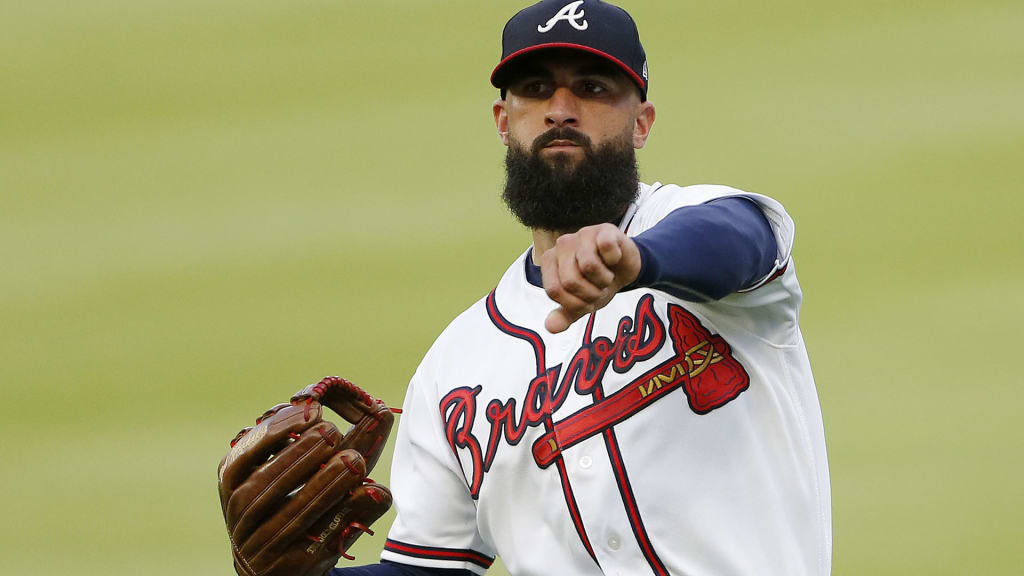
NORTH PORT, Fla. -- Braves manager Brian Snitker has acknowledged it would be challenging to carry five outfielders and provide each adequate playing time. But he also recognizes the potential benefits of keeping both Nick Markakis and Adam Duvall, even though one of them might be almost exclusively utilized as a pinch-hitter.
“[Carrying five outfielders] strengthens your bench, that’s for sure,” Snitker said. “Depending on how it all plays out, if they’re all on the ballclub, the ones that aren’t playing are really good options off the bench. In that respect, it just deepens our team.”
Before looking at what the Braves will evaluate before deciding whether to carry five outfielders on their 26-man roster, it’s important to remember Snitker has said left fielder Marcell Ozuna and right fielder Ronald Acuña Jr. are the only outfielders who are going to have everyday roles.
Ender Inciarte will get a majority of the starts in center field, but there’s a strong chance he’ll sit against left-handed pitchers.
Projecting the roles of those three outfielders is easy.
More difficult is answering how much playing time Markakis and Duvall would receive.
“I’ll be honest with you, I don’t know how it’s all going to pan out,” Snitker said.
An injury or a possible late-spring acquisition would alter current roster projections. But as things currently stand, there’s reason to question how Markakis will be utilized beyond being the team’s primary left-handed pinch-hitter.
When Inciarte sits against a southpaw, Acuña will shift to center field. The best option to then place in right field would be Duvall, who has an .842 OPS against left-handed pitchers dating back to the start of 2017. Four of the 10 homers he hit at the big league level last year came in 39 at-bats against lefties.
Markakis had an .809 OPS in the 60 plate appearances tallied against left-handers over last season’s final four months. This was actually better than the .765 OPS he produced against them in 2018. But he still has just a .727 OPS against lefties since the start of ‘17 and he has tallied just seven homers against them within that three-season span.
So how would Markakis best be utilized?
“He could play a role every day,” Snitker said. “Things happen. He’s the kind of guy you could stick in [the lineup] every day too.”
Looking only at current internal options, the Braves’ bench would be thin with left-handed pinch-hit options, especially if right-handed utility man Charlie Culberson gets a roster spot over switch-hitter Yangervis Solarte or left-handed slugger Yonder Alonso.
So, Markakis could bring significant value even if his opportunities to be in the lineup are restricted to days when Ozuna needs to rest. But the 36-year-old veteran has never filled a backup role and he has totaled just 16 pinch-hit plate appearances since debuting in 2006.
Still, there’s reason to be confident in Markakis’ ability to quickly adapt to this role and possibly extend his success against right-handed pitchers, who have surrendered an .823 OPS against him over the past two seasons. The three-batter minimum rule will lessen the likelihood of him being forced to face a left-hander in this role.
There’s also reason to question whether Duvall will be effective in a platoon role.
After acquiring Duvall from the Reds before the 2018 Trade Deadline, the Braves used him in left field and moved Acuña to center field on days when Inciarte sat against a left-hander. This plan was quickly nixed as Duvall struggled in a part-time role and ended up producing a woeful .342 OPS in 57 plate appearances for Atlanta.
But it should be noted Duvall tallied four homers and constructed a 1.105 OPS last September, despite starting just seven of the 15 games played during that month. He went 4-for-10 with two homers as a pinch-hitter in that span.
Still, even though the numbers suggest both Markakis and Duvall could both be effective in the matchups that might be created with them as pinch-hitters, Snitker and the front office must weigh whether they will remain effective while experiencing reduced playing time due to a crowded outfield mix.
“It’s very challenging,” Snitker said. “We’ll play this whole thing out and see where we’re at, at the end [of Spring Training]. It’s hard to find playing time for that many guys.”
